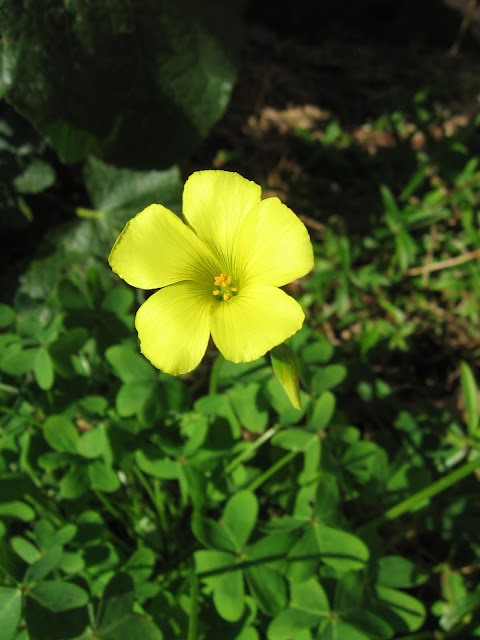
Hello sour grass, my old friend! Welcome back again. Here you are with one, lone, bright-faced bloom lighting up a neglected corner of the yard. Can spring be far behind?
It was such a splendid, dirt-under the fingernails day I ended up spending the whole morning in the garden. The usual inspection tour -- lately just a quick look around our damp, cold, scraggly, uninviting backyard patch -- turned into a flower photo op.
The first oxalis blossom opened nearly a month earlier than last year -- mid-January as opposed to the week of February 10. (One of the great features of a garden blog is the gradual accumulation of exact data from year to year.) Spring does seem to be running early. There are golden fields of wild mustard blooming already out by the coast and our neighborhood is sporting the first gorgeous tulip magnolias.

The volunteer arugula has put forth its trademark four-petaled blossom, delicately veined like the wings of some kind of exotic helicopter insect. I've seen the hummingbirds buzzing these blooms.

Here is borage -- not a very good photo. I'm sure it looks at lot better than this to the bees who gather here.

The pea plants are blooming again, unfurling like the Japanese folded paper flowers that "bloom" when you put them in water.

More flower origami: elegant black-trimmed fava bean blossoms are opening on three-foot tall stalks.

These hot pink rosettes aren't flowers at all, just some garden art that resulted from the thinning out of an overgrown clump of volunteer chard. Lots of the leaves had been so thoroughly mined by leaf miners that they had rotted into slime during the rainy spells. Yuk!
Undaunted, and energized by the unexpected spring day (I know, I know, it won't last), I weeded and trimmed until the plants could breath and soak up the sun. The lipstick chard pictured above is growing back from a venerable gnarled stump, all that's left of a plant that grew six or seven feet tall last season.

There are several varieties of chard in the patch, some growing from over-wintered stumps, some springing up for the first time.

Here's a shot of the north half of the winter garden. The oxalis and the borage are in the back corner where the fences meet; the arugula is to their right, the peas are in the foreground twining up the wooden stakes, the favas and the patch of chard are out of view to the right. In the foreground you can also see spinach, lacinato kale, and a bed of sponsored arugula. In the background are a couple of beds of lettuce. Out of view are broccoli and leeks. The paths are covered mostly with miner's lettuce. And that's about it.
We are harvesting lettuce, miner's lettuce, spinach, arugula, kale, and chard. We are waiting for broccoli, leeks, another round of peas, and favas.
Ready to pick or not, edible or not, everything looks beautiful on this fine spring day.










